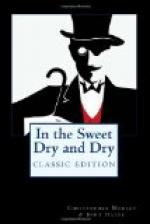Aedes TEMULENTI PERPETUI
E PLURIBUS UNUM
The little porch, under the marble columns, was cool and shady. A signboard said: Visiting Hours, Noon to Midnight. Quimbleton looked at his watch. “It’s not noon yet,” he said, “but as we’re old friends I dare say he’ll be willing to see us.”
Pushing through a slatted swinging door of beautifully carved bronze, they found themselves in a charmingly furnished reference library. There were lounges and deep leather chairs, and ash trays for smokers. Quimbleton, who was something of a bookworm, ran his eye along the shelves. “A very neat idea,” he said. “They have collected a little library of all the standard works on drink. This should be of great value to future historians and researchers.”
Through another swinging door they found the central shrine.
It was circular in shape, illuminated through a clear skylight. Under the rotunda was a low, broad marble counter, surmounted by a gleaming mirror and a noble array of bottles, flasks, decanters, goblets and glasses of every size. The pale yellow of white wines, the ruby of claret, the tawny brown of port, the green and violet and rose of various liqueurs, sparkled in their appointed vessels. In front of this altar stood a three-foot mahogany bar, with its scrolled rim and diminutive brass rail, all complete. A red velvet cord hung from brass posts separated it from the open floor.
A series of mural paintings, in the vivid coloring and superb technique of Maxfield Parrish, adorned the walls of the room. They portrayed the history of Alcohol from the dawn of time down to the summer of 1919. A space for one more painting was left blank, and Mr. and Mrs. Quimbleton concluded that the artist was still at work upon the final panel.
An attendant in white was polishing glasses behind the tiny bar. He was an elderly man with a pink clean-shaven face and the initials P. S. were embroidered on the collar of his starched jacket. There was an air of evident pride in his bearing as he listened to their exclamations of admiration.
“Your first visit, sir?” he said.
“Yes,” said Quimbleton. “I must confess I had no idea it would be as fine as this. What time does Mr. Bleak get in?”
“He usually opens up with a nip of Scotch about eleven-thirty,” said the bartender. “Just so as to get up a little circulation before opening time. He’s got a hard afternoon before him to-day,” he added.
“How do you mean?” said Quimbleton.
“One of the excursion trains coming. The railroad runs cheap excursions here three days a week, and the crowds is enormous. When there’s a bunch like that there’s always a lot wants Mr. Bleak to take some special drink they used to be partial to, just to recall old times. Of course, being what you might call a servant of the public, he doesn’t like not to oblige. But I doubt whether he’s got the constitution to stand it long. The other day the Mint Julep Veterans of Kentucky held a memorial day here, and Mr. Bleak had to sink fifteen juleps to satisfy them. I tell him not to push himself too far, but he’s still pretty new at the job. He likes to go over the top every day.”




